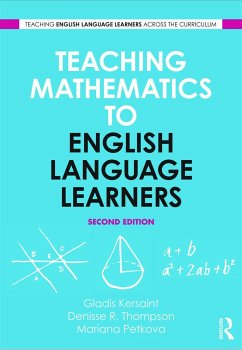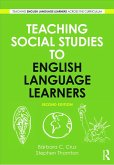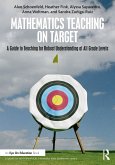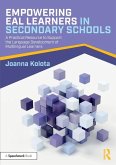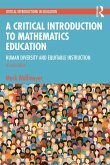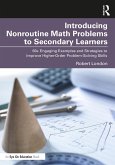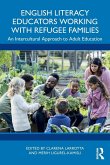Gladis Kersaint, Denisse R. Thompson, Mariana Petkova (USA University of South Florida)
Teaching Mathematics to English Language Learners
Gladis Kersaint, Denisse R. Thompson, Mariana Petkova (USA University of South Florida)
Teaching Mathematics to English Language Learners
- Broschiertes Buch
- Merkliste
- Auf die Merkliste
- Bewerten Bewerten
- Teilen
- Produkt teilen
- Produkterinnerung
- Produkterinnerung
This book provides readers a comprehensive understanding of both the challenges that face English language learners (ELLs) and ways in which educators might address them in the secondary mathematics classroom.
Andere Kunden interessierten sich auch für
![Teaching Social Studies to English Language Learners Teaching Social Studies to English Language Learners]() Stephen J. ThorntonTeaching Social Studies to English Language Learners75,99 €
Stephen J. ThorntonTeaching Social Studies to English Language Learners75,99 €![Teaching Social Studies to English Language Learners Teaching Social Studies to English Language Learners]() Barbara C. Cruz (USA University of South Florida)Teaching Social Studies to English Language Learners57,99 €
Barbara C. Cruz (USA University of South Florida)Teaching Social Studies to English Language Learners57,99 €![Mathematics Teaching On Target Mathematics Teaching On Target]() Alan SchoenfeldMathematics Teaching On Target46,99 €
Alan SchoenfeldMathematics Teaching On Target46,99 €![Empowering EAL Learners in Secondary Schools Empowering EAL Learners in Secondary Schools]() Joanna KolotaEmpowering EAL Learners in Secondary Schools24,99 €
Joanna KolotaEmpowering EAL Learners in Secondary Schools24,99 €![A Critical Introduction to Mathematics Education A Critical Introduction to Mathematics Education]() Mark WolfmeyerA Critical Introduction to Mathematics Education39,99 €
Mark WolfmeyerA Critical Introduction to Mathematics Education39,99 €![Introducing Nonroutine Math Problems to Secondary Learners Introducing Nonroutine Math Problems to Secondary Learners]() Robert LondonIntroducing Nonroutine Math Problems to Secondary Learners31,99 €
Robert LondonIntroducing Nonroutine Math Problems to Secondary Learners31,99 €![English Literacy Educators Working with Refugee Families English Literacy Educators Working with Refugee Families]() English Literacy Educators Working with Refugee Families53,99 €
English Literacy Educators Working with Refugee Families53,99 €-
-
-
This book provides readers a comprehensive understanding of both the challenges that face English language learners (ELLs) and ways in which educators might address them in the secondary mathematics classroom.
Hinweis: Dieser Artikel kann nur an eine deutsche Lieferadresse ausgeliefert werden.
Hinweis: Dieser Artikel kann nur an eine deutsche Lieferadresse ausgeliefert werden.
Produktdetails
- Produktdetails
- Teaching English Language Learners across the Curriculum
- Verlag: Taylor & Francis Ltd
- 2 ed
- Seitenzahl: 224
- Erscheinungstermin: 27. November 2012
- Englisch
- Abmessung: 254mm x 178mm x 12mm
- Gewicht: 430g
- ISBN-13: 9780415629775
- ISBN-10: 0415629772
- Artikelnr.: 36075609
- Herstellerkennzeichnung
- Libri GmbH
- Europaallee 1
- 36244 Bad Hersfeld
- gpsr@libri.de
- Teaching English Language Learners across the Curriculum
- Verlag: Taylor & Francis Ltd
- 2 ed
- Seitenzahl: 224
- Erscheinungstermin: 27. November 2012
- Englisch
- Abmessung: 254mm x 178mm x 12mm
- Gewicht: 430g
- ISBN-13: 9780415629775
- ISBN-10: 0415629772
- Artikelnr.: 36075609
- Herstellerkennzeichnung
- Libri GmbH
- Europaallee 1
- 36244 Bad Hersfeld
- gpsr@libri.de
Gladis Kersaint is Professor of Mathematics Education at the University of South Florida, USA. Denisse R. Thompson is a Professor of Mathematics Education at the University of South Florida, USA. Mariana Petkova has a Ph.D. in Mathematics Education from University of South Florida, USA.She worked as a Math teacher in an International Baccalaureate High School in Tampa and now works in the Educational System in Bulgaria.
Part 1
Your English Language Learner by Tony Erben 1.1 Orientation 1.2
The Process of English Language Learning and What to Expect 1.3
Different Types of ESOL Programs 1.4
Teaching for English Language 1.5
Not All ELLs are the Same1.6
Questions for Discussion and Reflection Part 2
Influences on the Mathematics Attainment of English Language Learners 2.1
Overview: Influences on the Mathematical Attainment of English Language Learners 2.2
Providing an Equitable Mathematics Education to English Language Learners: Mathematics Education 2.3
The Nature of Mathematics 2.4
Mathematics Teaching and Learning 2.5
Cultural Influences on Mathematics Learning and Engagement 2.6
Assessment Results, Practices, and Procedures 2.7
Questions for Discussion and Reflection Part 3
Best Practices to Support English Language Learners in the Mathematics Classroom 3.1
Overview: Classroom Environments that Support English Language Learners 3.2
Orchestrating Classroom Discourse to Support Mathematics Concepts and Language Development 3.3
Strategies to Help English Language Learners Understand Mathematics Language 3.4
Emphasizing and Supporting Problem 3.5
Assessing English Language Learners in Equitable Ways 3.6
Teaching Mathematics in Ways that are Culturally 3.7
Questions for Discussion and Reflection Part 4 Collaborations to Support ELLs 4.1 Overview: Collaborations to Support ELLs 4.2
Strategies for Mathematics Teachers Who are Themselves ELLs 4.3 Mathematics Teachers Collaborating with English as Second Language Learners 4.4 ELL Home
School Communication 4.5 Questions for Discussion and Reflection
Your English Language Learner by Tony Erben 1.1 Orientation 1.2
The Process of English Language Learning and What to Expect 1.3
Different Types of ESOL Programs 1.4
Teaching for English Language 1.5
Not All ELLs are the Same1.6
Questions for Discussion and Reflection Part 2
Influences on the Mathematics Attainment of English Language Learners 2.1
Overview: Influences on the Mathematical Attainment of English Language Learners 2.2
Providing an Equitable Mathematics Education to English Language Learners: Mathematics Education 2.3
The Nature of Mathematics 2.4
Mathematics Teaching and Learning 2.5
Cultural Influences on Mathematics Learning and Engagement 2.6
Assessment Results, Practices, and Procedures 2.7
Questions for Discussion and Reflection Part 3
Best Practices to Support English Language Learners in the Mathematics Classroom 3.1
Overview: Classroom Environments that Support English Language Learners 3.2
Orchestrating Classroom Discourse to Support Mathematics Concepts and Language Development 3.3
Strategies to Help English Language Learners Understand Mathematics Language 3.4
Emphasizing and Supporting Problem 3.5
Assessing English Language Learners in Equitable Ways 3.6
Teaching Mathematics in Ways that are Culturally 3.7
Questions for Discussion and Reflection Part 4 Collaborations to Support ELLs 4.1 Overview: Collaborations to Support ELLs 4.2
Strategies for Mathematics Teachers Who are Themselves ELLs 4.3 Mathematics Teachers Collaborating with English as Second Language Learners 4.4 ELL Home
School Communication 4.5 Questions for Discussion and Reflection
Part 1
Your English Language Learner by Tony Erben 1.1 Orientation 1.2
The Process of English Language Learning and What to Expect 1.3
Different Types of ESOL Programs 1.4
Teaching for English Language 1.5
Not All ELLs are the Same1.6
Questions for Discussion and Reflection Part 2
Influences on the Mathematics Attainment of English Language Learners 2.1
Overview: Influences on the Mathematical Attainment of English Language Learners 2.2
Providing an Equitable Mathematics Education to English Language Learners: Mathematics Education 2.3
The Nature of Mathematics 2.4
Mathematics Teaching and Learning 2.5
Cultural Influences on Mathematics Learning and Engagement 2.6
Assessment Results, Practices, and Procedures 2.7
Questions for Discussion and Reflection Part 3
Best Practices to Support English Language Learners in the Mathematics Classroom 3.1
Overview: Classroom Environments that Support English Language Learners 3.2
Orchestrating Classroom Discourse to Support Mathematics Concepts and Language Development 3.3
Strategies to Help English Language Learners Understand Mathematics Language 3.4
Emphasizing and Supporting Problem 3.5
Assessing English Language Learners in Equitable Ways 3.6
Teaching Mathematics in Ways that are Culturally 3.7
Questions for Discussion and Reflection Part 4 Collaborations to Support ELLs 4.1 Overview: Collaborations to Support ELLs 4.2
Strategies for Mathematics Teachers Who are Themselves ELLs 4.3 Mathematics Teachers Collaborating with English as Second Language Learners 4.4 ELL Home
School Communication 4.5 Questions for Discussion and Reflection
Your English Language Learner by Tony Erben 1.1 Orientation 1.2
The Process of English Language Learning and What to Expect 1.3
Different Types of ESOL Programs 1.4
Teaching for English Language 1.5
Not All ELLs are the Same1.6
Questions for Discussion and Reflection Part 2
Influences on the Mathematics Attainment of English Language Learners 2.1
Overview: Influences on the Mathematical Attainment of English Language Learners 2.2
Providing an Equitable Mathematics Education to English Language Learners: Mathematics Education 2.3
The Nature of Mathematics 2.4
Mathematics Teaching and Learning 2.5
Cultural Influences on Mathematics Learning and Engagement 2.6
Assessment Results, Practices, and Procedures 2.7
Questions for Discussion and Reflection Part 3
Best Practices to Support English Language Learners in the Mathematics Classroom 3.1
Overview: Classroom Environments that Support English Language Learners 3.2
Orchestrating Classroom Discourse to Support Mathematics Concepts and Language Development 3.3
Strategies to Help English Language Learners Understand Mathematics Language 3.4
Emphasizing and Supporting Problem 3.5
Assessing English Language Learners in Equitable Ways 3.6
Teaching Mathematics in Ways that are Culturally 3.7
Questions for Discussion and Reflection Part 4 Collaborations to Support ELLs 4.1 Overview: Collaborations to Support ELLs 4.2
Strategies for Mathematics Teachers Who are Themselves ELLs 4.3 Mathematics Teachers Collaborating with English as Second Language Learners 4.4 ELL Home
School Communication 4.5 Questions for Discussion and Reflection

